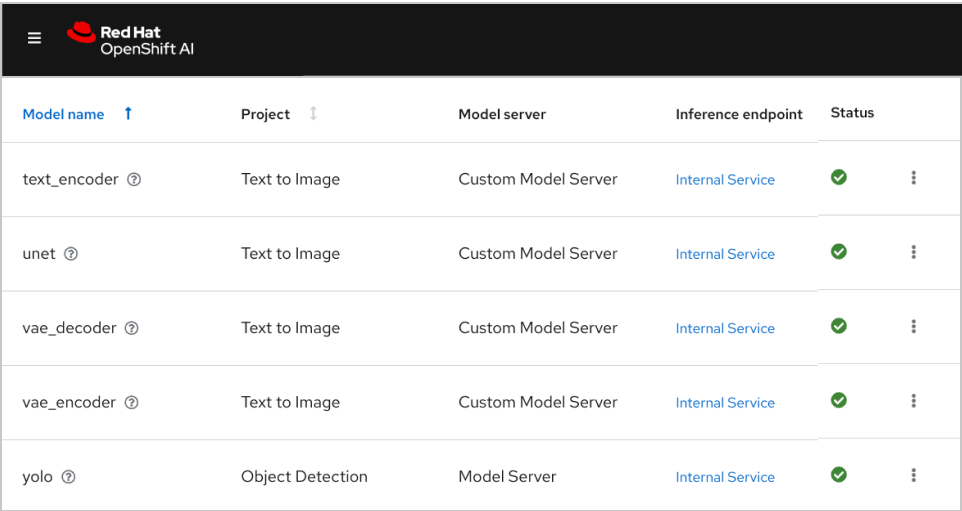Red Hat OpenShift AI
What is Red Hat OpenShift AI?
Red Hat® OpenShift® AI is a flexible, scalable artificial intelligence (AI) and machine learning (ML) platform that enables enterprises to create and deliver AI-enabled applications at scale across hybrid cloud environments.
Built using open source technologies, OpenShift AI provides trusted, operationally consistent capabilities for teams to experiment, serve models, and deliver innovative apps.
Bring AI-enabled apps to production faster
Combine the proven capabilities of Red Hat OpenShift AI and Red Hat OpenShift in a single enterprise-ready AI application platform that brings teams together. Data scientists, engineers, and app developers can collaborate in a single destination that promotes consistency, security, and scalability.
OpenShift AI enables data acquisition and preparation, model training and fine-tuning, model serving and model monitoring, and hardware acceleration. With an open ecosystem of hardware and software partners, OpenShift AI delivers the flexibility you need for your specific use cases.
The latest release of Red Hat OpenShift AI delivers enhanced support for predictive and generative AI (gen AI) model serving, improves efficiency of data processing and model training, and extends your ability to deploy AI models in remote locations at the edge.
Features & benefits
Less time managing AI infrastructure
Provide your teams with on-demand access to resources, so they can focus on exploring data and building apps that add real value to your organization. Additional time-saving benefits include built-in security and operator life cycle integration.
Tested and supported AI/ML tooling
Red Hat tracks, integrates, tests, and supports common AI/ML tooling and model serving on our Red Hat OpenShift application platform, so you don’t have to. OpenShift AI draws from years of incubation in Red Hat’s Open Data Hub community project and open source projects like Kubeflow.
Flexibility across the hybrid cloud
Offered as either self-managed software or as a fully managed cloud service on top of OpenShift, Red Hat OpenShift AI provides a secure and flexible platform that gives you the choice of where you develop and deploy your models–whether on-premise, the public cloud, or even at the edge.
Leverage our best practices
Red Hat Consulting provides services that allow you to install, configure and use Red Hat OpenShift AI to its fullest extent.
Whether you’re pursuing an OpenShift AI pilot experience or need guidance on building your MLOps foundation, Red Hat Consulting will provide support and mentorship.
Red Hat Enterprise Linux AI
Red Hat® Enterprise Linux® AI is a foundation model platform used to seamlessly develop, test, and run Granite family large language models (LLMs) for enterprise applications.
Partnerships
Get more from the Red Hat OpenShift AI platform by extending it with other integrated services and products.
NVIDIA and Red Hat offer customers a scalable platform that accelerates a diverse range of AI use cases with unparalleled flexibility.
Intel® and Red Hat help organizations accelerate AI adoption and rapidly operationalize their AI/ML models.
IBM and Red Hat provide open source innovation to accelerate AI development, including through IBM watsonx.aiTM, an enterprise-ready AI studio for AI builders.
Starburst Enterprise and Red Hat support better and more timely insights through rapid data analysis across multiple disparate and distributed data platforms.
Expand your AI capabilities with IBM watsonx.ai
Red Hat OpenShift AI provides the open source foundation for IBM watson.ai, which provides additional gen AI capabilities.
Collaborating through Jupyter notebooks-as-a-service
Provide pre-built or customized cluster images to your data scientists to build models using Jupyter notebooks. Red Hat OpenShift AI tracks changes to Jupyter, TensorFlow, and PyTorch, and other open source AI technologies.
Scaling Model Serving with Red Hat OpenShift AI
Models can be served for integration into intelligent applications on-premise, in the public cloud or at the edge. These models can be rebuilt, redeployed, and monitored based on changes to the source notebook.
Explore related resources
Video
Demo of Red Hat OpenShift AI
E-book
Top considerations for building a foundation for generative AI
Analyst material
Omdia report: Building a strong operational foundation for AI
Checklist
Top 5 ways to implement MLOps successfully in your organization







